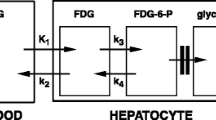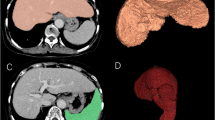Abstract
A multicentre study on multicompartmental analysis of hepatic scintigraphy using technetium-99m labelled galactosyl serum albumin (GSA), which binds to the asialoglycoprotein receptor, was carried out at seven institutions in Japan. Seventy-four patients with liver disease received 3 mg (185 MBq) of99mTc-GSA by intravenous injection. Sequential scanning was performed 30 min after injection to obtain anterior images of the heart and liver, followed by single-photon emission tomography (SPET). The indices included in this analysis were hepatic blood flow (Q) and maximal receptor binding rate (R max), which showed a good correlation with semiquantitative ratio indices for99mTc-GSA, namely the retention rate in blood (HH15) and the hepatic uptake rate (LHL15).Q andR max also showed a significant correlation with other measures of hepatic function. When patients were grouped according to the severity of chronic liver damage (hepatocellular functional damage),Q was reduced in the moderate and severe groups, whileR max was reduced in proportion to the functional stage. Both parameters showed no inter-institution difference using analysis of co-variance with the functional stage as a co-variant. With regard to the hepatic uptake rate, anterior planar images and SPET images gave similar results forQ andR max. Acquisition times of 15 or 30 min provided the same results. The multicopartmental model analysis permitted comparable results to be obtained at institutions using different gamma cameras, and is therefore considered a universally applicable method. These results indicate thatQ andR max are useful general indices for evaluating the function reserve capacity of the liver.
Similar content being viewed by others
References
Morell AG, Irvine RA, Sternlieb I, Scheunberg IH, Ashwell G. Physical and chemical studies on ceruloplasmin V. Metabolic studies on sialic acid-free ceruloplasmin in vivo.J Biol Chem 1968: 243: 155–159
AshwelL G, Morell AG. The role of surface carbohydrates in the hepatic recognition and transport of circulating glycoproteins.Adv Enzymol 1974; 41: 99–128.
Stockert RJ, Becker FF. Diminished hepatic binding protein for desialylated glycoproteins during chemical hepatocarcinogenesis.Cancer Res 1980; 40: 3632–3634.
Vera DR, Krohn KA, Stadalnik RC. Radioligands that bind to cell-specific receptors: hepatic binding protein ligands for hepatic scintigraphy. In: Sodd VJ, Hoogland DR, Ice RD, Sorensen JA, (eds.)Radiopharmaceuticals II. Proceedings of the 2nd International Symposium on Radiopharmaceuticals. New York: The Society of Nuclear Medicine; 1979: 565–575.
Kawa S, Hazama H, Kojima M et al. A new liver function test using the asialoglycoprotein-receptor system on the liver cell membrane. II. Quantitative evaluation of labeled neoglycoprotein clearance.Jpn J Nucl Med 1986; 23: 907–916.
Galli G, Maini CL, Orlando P et al. A radiopharmaceutical for the study of the liver:99mTc-DTPA-asialo-orosomucoid. II. Human dynamic and imaging studies.J Nucl Med Allied Sci 1988: 32: 117–126.
Bossuyt A, De Geeter F, Jacobs A, Camus M, Thornback JR. Initial clinical experience with a new kit formulation of Tc-99m-b galactosylated albumin for functional hepatic imaging.Nucl Med Commun 1990; 11: 469–475.
Kudo M, Todo A, Ikekubo K, Kino M. Receptor index via hepatic asialoglycoprotein receptor imaging: correlation with chronic hepatocellular damage.Am J Gastroenterol 1992; 87: 865–870.
Ha-Kawa SK, Tanaka Y. A quantitative model of technetium-99m-DTPA-galactosyl-HSA for the assessment of hepatic blood flow and hepatic binding receptor.J Nucl Med 1991; 32: 2233–2240.
Virgolini I, Kornek G, Hobart J et al. Scintigraphic evaluation of functional hepatic mass in patients with advanced breast cancer.Br J Cancerk 1993; 68: 549–554.
Vera DR, Stadalnik RC, Trudeau WL, Scheibe PO, Krohn KA. Measurement of receptor concentration and forward-binding rate constant via radiopharmacokinetic modeling of technetium-99m-galactosyl-neoglycoalubumin.J Nucl Med 1991; 32: 1169–1176.
Torizuka K, Ikekuba K, Ha-Kawa SK, et al. Phase I clinical study on99mTc-GSA, a new agent for functional imaging of the liver.Jpn J Nucl Med 1991; 28: 1321–1331
Torizuka K, Ha-Kawa SK, Kudo M et al. Phase II clinical study on99mTc-GSA, a new agent for functional imaging of the liver.Jpn J Nucl Med 1992; 29: 85–95.
Torizuka K, Ha-Kawa SK, Kudo M, et al. Phase III Multi-center clinical study on99mTc-GSA, a new agent for functional imaging of the liver.Jpn J Nucl Med 1992; 29: 159–181.
Paumgartner G, Probst P, Kraines R, Leevy CM Kinetics of indocyanine green removal from the blood.Ann NY Acad Sci 1970; 170: 134–147.
Yamaoka K, Nakagawa T. A nonlinear least squares program bases on differential equations, MULTI(RUNGE), for microcomputers.J Pharmacobiodyn 1983; 6: 595–606.
Liver Cancer Study Group of Japan.The general rules for the clinical and pathological study of primary liver cancer, 2nd edn [in Japanese] Tokyo: Kanehara; 1987: 23.
Schwartz AL, Fridovich SE, Knowles BB, Lodish HF. Characterization of the asialoglycoprotein receptor in a continuous hepatoma line.J Biol Chem 1981; 256: 8878–8881.
Dodeur M, Durand D, Dumont J, et al. Effects of streptozotocin-induced diabetes mellitus on the binding and uptake of asialoorosomucoid by isolated hepatocytes from rats.Eur J Biochem 1982; 123: 383–387
Appel M, Potrat P, Feger J, Mas-Chamberlin C, Durand G. In vivo quantification of removal of asialo-orosomucoid from the circulation in anaesthetized streptozotocin-diabetic rats.Diabetologia 1986; 29: 383–387.
Kudo M, Todo A, Ikekubo K et al. Functional hepatic imaging with receptor-binding radiopharmaceutical: clinical potential as a measurement of functional hepaotcyte mass.Gastronterol Jpn 1991; 26: 734–741.
Branch RA, Shand DG. Propranolol disposition in chronic liver disease: a physiological approach.Clin Pharmacokinet 1976; 1: 264–279.
Zaramelia MG, Vailini R, Tiribelli C. Estimation of the hepatic blood “flow” by galactose plasma clearance in patients with liver disease.Liver 1985; 5: 129–133.
Sawamura T, Nakada H, Hazama H, et al. Hyperasialoglyco-proteinemia in patients with chronic liver diseases and/or liver cell carcinoma. Asialoglycoprotein receptor in cirrhosis and liver cell carcinoma.Gastroenterology 1984; 87: 1217–1221.
Feruglio FS, Greco F, Cesano L, et al. Effect of drug infusion on the systemic and splanchnic circulation. I. Bradykinin infusion in normal subjects.Clin Sci 1964; 26: 487–491.
Author information
Authors and Affiliations
Rights and permissions
About this article
Cite this article
Ha-Kawa, S.K., Tanaka, Y., Hasebe, S. et al. Compartmental analysis of asialoglycoprotein receptor scintigraphy for quantitative measurement of liver function: A multicentre study. Eur J Nucl Med 24, 130–137 (1997). https://doi.org/10.1007/BF02439544
Received:
Revised:
Issue Date:
DOI: https://doi.org/10.1007/BF02439544




